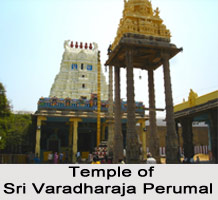 Sri Varadaraja Svami temple is an important temple dedicated to Lord Sri Sudarshana. The Chakrattazhvar (Lord Sri Sudarshana) shrine in the Varadaraja Svami temple in Kanchipuram (Vishnu Kanchi) is erected on the eastern side of the Anantasaras tank. The Anantasaras tank is considered extremely sacred, which is situated to the left of the west gopura of this temple. The Temple complex is spacious. The sanctum also houses the image of Lord Sudarsana with Yoga Narasimha on the rear side. This stone (moolavar) as well as the metal (utsava) images of Sudarsana in this temple are most impressive. The utsava murti or the processional image is very unique and placed within the round framework. The processional image represents as many as seven figures of Chakrattazhvar in standing posture. The principal one is fixed in the centre and six smaller ones are arranged in each of the small peripheral triangles of the rays of the six pointed star. This iconographic form is rare and happens to be the chief attraction of this shrine. Since there are two icons in the same image, there are two entrances to this shrine, one on the west and the other on the east.
Sri Varadaraja Svami temple is an important temple dedicated to Lord Sri Sudarshana. The Chakrattazhvar (Lord Sri Sudarshana) shrine in the Varadaraja Svami temple in Kanchipuram (Vishnu Kanchi) is erected on the eastern side of the Anantasaras tank. The Anantasaras tank is considered extremely sacred, which is situated to the left of the west gopura of this temple. The Temple complex is spacious. The sanctum also houses the image of Lord Sudarsana with Yoga Narasimha on the rear side. This stone (moolavar) as well as the metal (utsava) images of Sudarsana in this temple are most impressive. The utsava murti or the processional image is very unique and placed within the round framework. The processional image represents as many as seven figures of Chakrattazhvar in standing posture. The principal one is fixed in the centre and six smaller ones are arranged in each of the small peripheral triangles of the rays of the six pointed star. This iconographic form is rare and happens to be the chief attraction of this shrine. Since there are two icons in the same image, there are two entrances to this shrine, one on the west and the other on the east.
There are a number of inscriptions imprinted on the walls of the temple. The inscriptions provide much important information about the temple. As these epigraphic evidences suggest this sanctum appears to have been constructed during the reign of the later Chola king Kulottunga III in 1191 A.D. The inscriptions also suggest the name of the person as Ilaiyazhvan Kalingarayan of Nettur, who constructed the temple. This is mentioned in an epigraph in this temple which refers to this deity by his Tamil name Tiru-aazhi-Azhvar-aazhi.
In the later period several renovations were made to the Temple in the Vijayanagara period. The kings of Vijayanagara were staunch followers of Vaishnavism. The structural design henceforth bears out the essence of the Vijaynagra Style. There are two mukha-mandapas in front of the two entrances, which belongs to the Vijayanagara period as seen from the pillars, which are typical products of this era. The state emblem or crest of the imperial house of Vijayanagara consisting of the boar with a dagger in front is clearly imprinted on the ceiling of the mandapa on the western side of this sanctum. The main portion of the ceiling represents the sculpture of a fully blossomed lotus around which are carved some episodes relating to Lord Krishna`s life. This includes the incidents such as Krishna killing the demon Bakasura, destroying an asura in the form of a calf (Dhenukasura), eating butter, etc. The other sculptures found here are of Lord Rama, Lakshmana and Sita and another of Lord Vishnu seated on Garuda (Garudarooda). The images of the deities are immensely captivating.





















